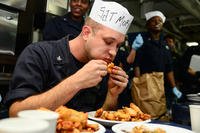Insulin resistance has been brought to our attention with more studies, reports, Ted Talks, articles by doctors, and even an article I wrote, titled "Biggest Health Problem in the U.S.," yet there are no significant programming or dieting changes recommended by the government health and medical community. There are, however, a few in the medical and nutrition field who have been waving the red flag for years as our country is now sporting 70% overweight or obese numbers.
Now, even our military is representing those numbers as more and more active-duty members are overweight or obese. With a national Type 2 diabetes and pre-diabetes rate of 37%, it is only a matter of time before our national crisis affects the pool of military candidates on a strategic level. In fact, Type 2 diabetes has doubled in the last 10 years and quadrupled since 1980.
Currently, the number one reason why young men and women cannot join the military is that they fail to meet the height, weight and body-fat percentage minimum standards. So our nation’s health and wellness already has started to affect recruiting numbers.
Insulin resistance is pre-pre-diabetes and a precursor to other conditions such as a heart attack, Alzheimer’s Disease, cancer, kidney disease, stroke, gout, obesity and, of course, Type 2 diabetes. Recent studies are linking insulin resistance to Type 2 diabetes and Alzheimer’s to a degree that Alzheimer’s is being considered Type 3 diabetes, Dr. Georgia Ede said.
We are rapidly becoming a nation of insulin resistant bodies -- unable to metabolize sugar properly. Since more than half of the American population are insulin resistant, you should know more about this dangerous precursor to disease. The difference between insulin resistance and insulin sensitivity is the same as saying unhealthy and healthy with regard to blood sugar and other common health numbers.
You want to be sensitive to the effects of insulin, so that it can do its job and help you metabolize carbohydrates. Insulin resistance is a hormonal condition that basically makes our body unable to process carbohydrates, thus elevating blood-sugar levels, creating inflammation and interfering with fat and cholesterol metabolism. However, you do not have to be overweight to be insulin resistant.
Who is to blame?
To blame our overweight and excessive carb status on the government guidelines is not overreaching, with current information about Big Sugar driving studies and health information toward fat being the biggest culprit to our poor health in more than 50 years. The current nutrition guidelines require a moderate number of daily calories, but as a nation, we eat almost double (3,770 a day) our daily caloric recommended rate of 2,000 a day.
And most of these recommended calories come from carbohydrates. Once you are insulin resistant or pre-diabetic, your diet has to change. You should start thinking and eating like a diabetic. That means eliminating sugar and limiting other carbs, such as grains, potatoes and anything processed. Try to limit your daily carbs to 50 grams a day, see how you feel and monitor the results.
How do you know if you have insulin resistance?
There is an easy method to determine your insulin resistance ratio (IRR): divide your triglycerides by HDLs. E.J. Greenwald of SpecialtyHealth in Reno, Nevada, said this is a basic method to see whether further testing needs to be done. Any ratio of more than 2.5 for women and 3.0 for men means you are insulin resistant.
"When humans become insulin resistant, the glucose receptors of our liver and muscle cells get clogged," Greenwald said. "Glucose stays in the bloodstream, and blood glucose levels increase and so does the blood insulin levels as the pancreas keeps pumping more and more insulin to try to keep blood sugar (glucose) levels under control.”
The more accurate measure is to take a nuclear magnetic resonance (NMR) spectroscopy of your blood. Basically, this MRI of your blood measures the numbers of different particles that carry cholesterol and triglycerides.
If you are curious, do the math on your own IR ratio, then ask your doctor to take your blood and test it. If you can get a 10- to 15-year head start on diabetes, would you take steps to prevent it?
For more details of a typical health screening and treatment for such ailments, see the Health Screening 101 Series.
Stew Smith is a former Navy SEAL and fitness author certified as a Strength and Conditioning Specialist (CSCS) with the National Strength and Conditioning Association. Visit his Fitness eBook store if you’re looking to start a workout program to create a healthy lifestyle. Send your fitness questions to stew@stewsmith.com.
Want to Learn More About Military Life?
Whether you're thinking of joining the military, looking for fitness and basic training tips, or keeping up with military life and benefits, Military.com has you covered. Subscribe to Military.com to have military news, updates and resources delivered directly to your inbox.



















